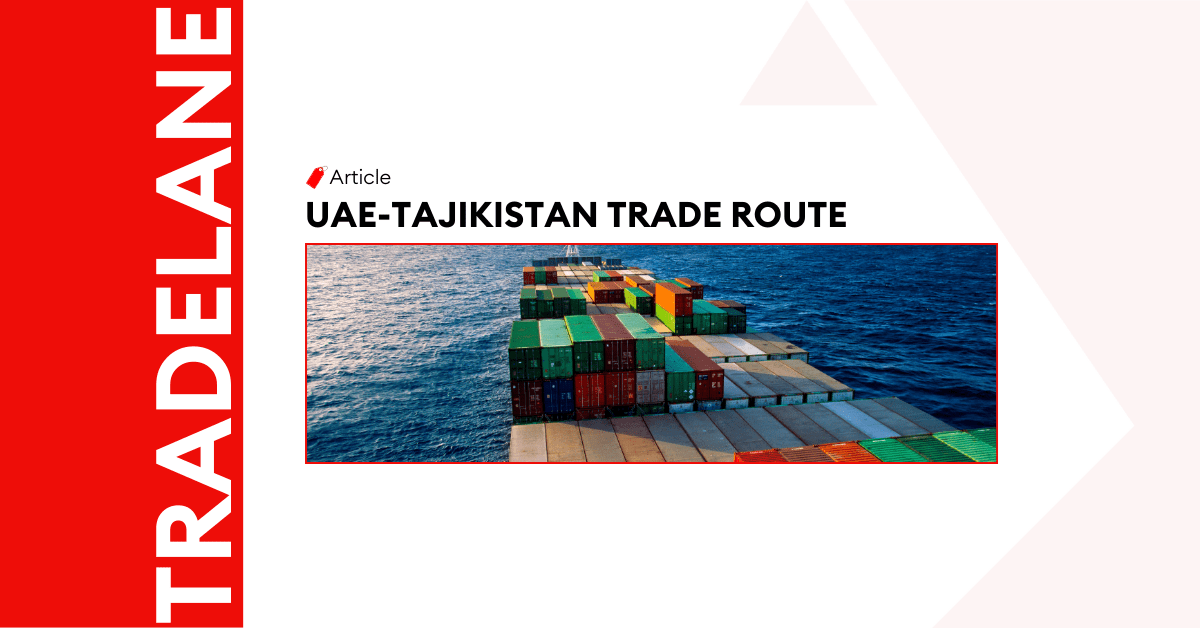
Navigating the UAE-Tajikistan Trade Route – A Complete Guide
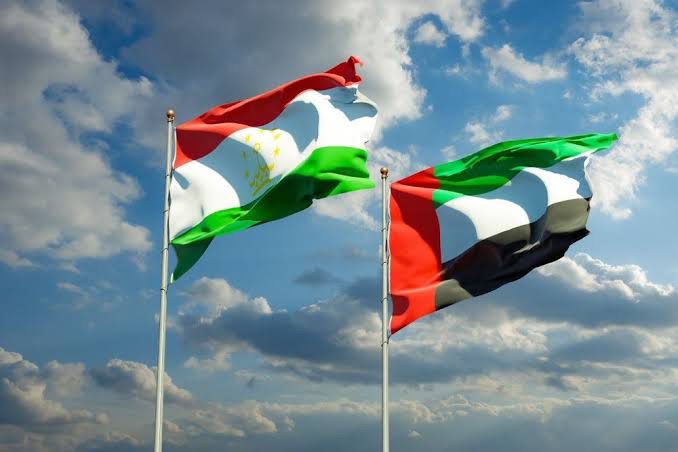
Introduction
Over the years, the bilateral trade between the UAE and Tajikistan has shown remarkable growth. In 2021, the UAE exported goods and services worth over $80 million to Tajikistan, including fibers, air conditioning units, and cars. Conversely, Tajikistan’s exports to the UAE included metals, raw cotton, and automobiles.
Strategically, the UAE’s investments in Tajikistan span various sectors such as energy, water, mining, and tourism. These investments aim to enhance Tajikistan’s economic infrastructure and diversify its economy.
A Comparative Economic Snapshot of UAE and Tajikistan
A Deep Dive into the UAE's Economic Landscape
The United Arab Emirates (UAE) boasts a highly competitive and diversified economy, ranking among the most advanced globally. This achievement stems from strategic economic policies, robust financial management, and significant investments in non-oil sectors.
Industries Leading UAE’s Economic Growth
- Oil and Gas: Despite diversification efforts, the oil and gas sector contribute significantly to national revenues and exports.
- Tourism: The UAE is renowned for its luxury resorts, shopping experiences, and cultural attractions in cities like Dubai and Abu Dhabi.
- Aviation: Leading airlines such as Emirates and Etihad means the UAE is a global hub.
- Logistics: The UAE is strategically located and maintains state-of-the-art ports, such as Jebel Ali.
Top Goods Driving UAE's Global Trade
The UAE’s diverse export portfolio includes crude oil, refined petroleum products, natural gas, gold, aluminum, and plastics. This diversification reflects the country’s strategic efforts to reduce reliance on oil.
UAE's Key Global Trading Partners
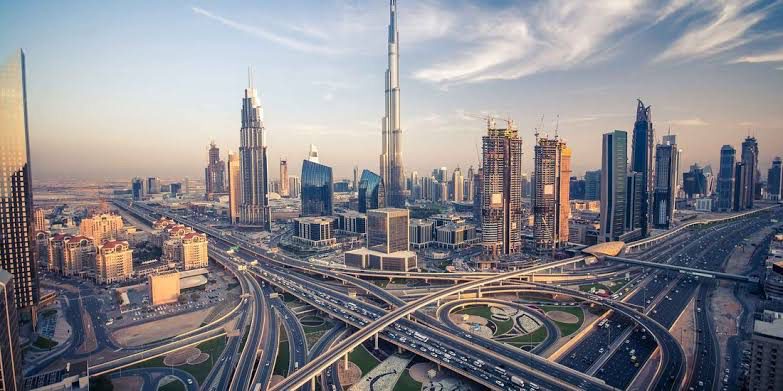
The UAE engages with key global partners such as China, India, the United States, and countries within the European Union.
Insights into Tajikistan’s Economy
An Overview of Tajikistan’s Economic Framework
Tajikistan’s GDP has been on an upward trend, reaching a growth rate of 8.2% in early 2024. This growth is largely fueled by the mining sector, which benefits from the country’s rich mineral resources, and the agricultural sector.
The government is equally committed to improving the business environment and attracting foreign investment. Efforts to streamline regulatory processes and promote private sector development are beginning to yield positive results.
Why Invest in Tajikistan?
Strategic Location and Regional Connectivity
Tajikistan, strategically located in Central Asia, serves as a crucial link between the East and the West. Its proximity to major markets like China, Russia, and South Asia positions it as a key transit country in the region. The country’s inclusion in significant regional initiatives, such as the Belt and Road Initiative (BRI), enhances its connectivity and trade potential, making it an attractive destination for investment.
Untapped Natural Resources
Tajikistan boasts abundant natural resources, particularly in hydropower, minerals, and agriculture. With over 60% of Central Asia’s water resources, Tajikistan has significant potential for hydropower development, making it a leading producer and exporter of electricity in the region. Additionally, the country is rich in precious metals like gold, silver, and rare earth elements, offering lucrative opportunities for mining and resource extraction industries.
Government Support and Investment Incentives
The Tajik government has implemented a series of reforms to create a more favorable business environment for foreign investors. These include tax incentives, simplified regulatory procedures, and the establishment of Free Economic Zones (FEZs) that offer benefits such as tax holidays and customs duty exemptions. These measures are aimed at attracting Foreign Direct Investment (FDI) and fostering sustainable economic development.
Growing Market Opportunities
Tajikistan’s economy is on a growth trajectory, driven by rising domestic demand and increasing regional trade. Sectors such as energy, agriculture, manufacturing, and infrastructure are ripe for investment, offering high returns for investors. The country’s young and growing population further contributes to a dynamic market environment with expanding consumer needs.
Commitment to Sustainable Development
Tajikistan is committed to achieving Sustainable Development Goals (SDGs), with a focus on renewable energy, poverty reduction, and social inclusion. By investing in Tajikistan, companies can contribute to these goals while benefiting from a stable and supportive investment climate. This commitment enhances the long-term prospects for businesses operating in the country, making it an ideal destination for sustainable investments.
Introduction to the UAE-Tajikistan Trade Lane
Major Sectors Driving UAE-Tajikistan Trade
Several significant sectors drive trade activities between the UAE and Tajikistan:
- Automotive Industry: Cars and automotive parts from the UAE to Tajikistan are substantial exports.
- Electronics and Appliances: The UAE exports significant air conditioning units and electronic devices.
- Mining and Metals: Tajikistan exports alkaline metals and gold to the Emirates.
Top Exports and Imports between the UAE and Tajikistan
The UAE’s main exports to Tajikistan include cars, air conditioners, and unprocessed artificial staple fibers. Conversely, Tajikistan’s top exports to the UAE are alkaline metals, planes and helicopters, and gold.
Major Trading Partners in the UAE-Tajikistan Trade Lane
The UAE maintains robust trade relationships with India, China, and the United States, which are crucial for its diverse export portfolio. Tajikistan has regional partners in Central Asia like Kazakhstan and Uzbekistan, while also engaging in significant trade with Russia and China.
Exploring Shipping Routes and Transport Options
Mapping Key Transport Corridors
Strategic Transport Routes to Tajikistan
Several significant transport corridors enhance the connectivity between the UAE and Tajikistan:
- Middle Corridor: This multimodal route links China to the European Union via Central Asia, including Tajikistan. It bypasses Russia and Iran, offering a strategic alternative under current geopolitical conditions.
- North-South Transport Corridor: This corridor connects the UAE to Central Asia through Iran and the Caspian Sea. The corridor’s efficiency is further enhanced by integrating road, rail, and sea transport.
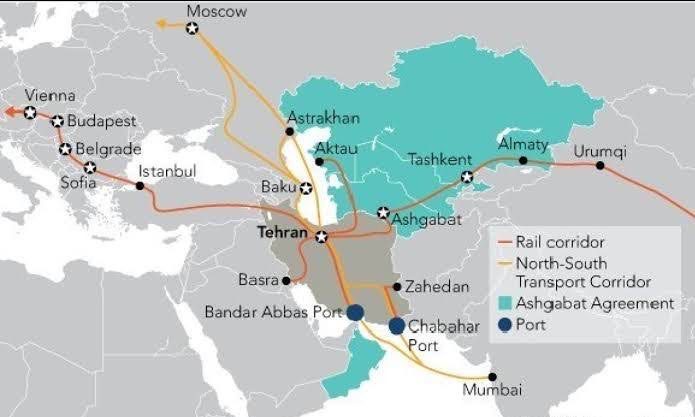
- CASCA+ Route: Integrating Central Asia, South Caucasus, and Turkey, the CASCA+ route offers a comprehensive multimodal transportation solution. The CASCA+ route is significant as it supports substantial volumes of container traffic.
Strategic Shipping Routes Connecting UAE to Tajikistan
Sea Freight Details
Sea freight logistics are pivotal in shipping from Dubai to Tajikistan, offering cost-effective and flexible solutions for shipping goods. Companies like Al Sharqi provide Full Container Loads (FCL) and Less Than Container Loads (LCL) shipping options. Al Sharqi efficiently handles shipments from Dubai to Tajikistan by providing customs brokerage, freight forwarding, and insurance.
The primary sea routes for shipping to Tajikistan involve multimodal transportation, integrating sea and land transport due to Tajikistan’s landlocked nature. Key routes include:
- Via the Caspian Sea: Goods are shipped from UAE ports to ports in Iran or Azerbaijan and then go by rail or road to Tajikistan. This route connects to Central Asian markets in around 15-20 days.
- North-South Transport Corridor: Connecting the UAE through Iran and the Caspian Sea, this corridor reduces transit times to about 20-25 days.
- Middle Corridor: Bypassing Russia and Iran, this route links the UAE to Central Asia through Turkey and the Caucasus. The transit time for this route is generally between 25-30 days.
Air Freight in UAE-Tajikistan Trade
Air freight services to Tajikistan is vital for the trade connection to the UAE, offering a fast, secure, and efficient transportation solution for perishable goods, electronics, and other valuable commodities.
These airports are supported by major airlines such as Emirates SkyCargo and Etihad Cargo, ensuring seamless connectivity and efficient logistics solutions. Typical transit times for air freight range from 1 to 3 days, depending on the specific service and route.
Major Ports in UAE-Tajikistan Trade Lane
Several major ports facilitate trade between the UAE and Tajikistan:
- Jebel Ali Port: Located in Dubai, it is the largest man-made harbor globally and a major logistics hub connecting to Central Asia.
- Khalifa Port: Situated in Abu Dhabi, this deepwater port accommodates the largest container ships.
- Port of Fujairah: Providing access to the Indian Ocean, this port offers an alternative route bypassing the Strait of Hormuz.
- Port of Bandar Abbas (Iran): This port is a key gateway for goods transported via the North-South Corridor, linking UAE sea freight with rail and road networks into Tajikistan.
- Port of Gwadar (Pakistan): Another strategic port facilitating the movement of goods from the UAE to Central Asia.
Key Airports and Airlines
Several major airports move air freight to Tajikistan from the UAE, including:
- Dubai International Airport (DXB): A global hub, DXB handles significant cargo volumes, with Emirates SkyCargo operating extensive routes to Central Asia, including Tajikistan.
- Zayed International Airport (AUH): Abu Dhabi has heavily invested in its cargo facilities, including state-of-the-art terminals and advanced cargo management systems. Etihad Cargo, based at AUH, offers extensive air freight services to over 70 destinations worldwide, including Tajikistan.
- Sharjah International Airport (SHJ): Known for its cargo efficiency, SHJ handles substantial cargo volumes from Tajikistan and has recently expanded its facilities to accommodate specialized shipments.
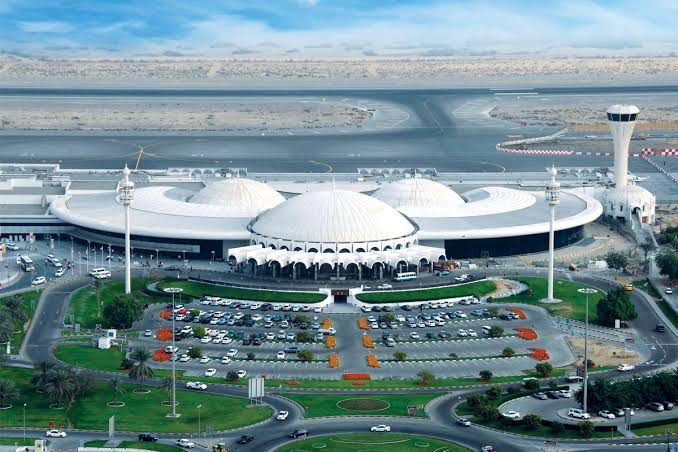
Key Customs Procedures and Regulations
A Guide to Tajikistan’s Customs Procedures
Key Export Paperwork and Requirements
Exporting goods from Tajikistan to the UAE requires several key documents, including:
- Commercial Invoice: Detailing the goods being exported, their value, and the terms of sale.
- Packing List: Providing information on each shipment’s contents, weight, and packaging for each shipment.
- Certificate of Origin: Verifying the origin of the goods, often required to qualify for preferential tariff rates.
- Export License: Necessary for goods subject to export controls.
Import Regulations in Tajikistan
Importing cargo to Tajikistan involves complying with various regulations, tariffs, and taxes. Key import regulations include:
- Customs Declarations: All imported goods must be declared at the border, with detailed information about their nature, quantity, and value.
- Import Tariffs: Depending on the type of goods, tariffs can vary significantly, and businesses should know the applicable rates.
- Value-Added Tax (VAT): Imported goods are subject to VAT, typically around 18%.
- Import Restrictions: Certain goods attract restrictions or prohibitions, including hazardous materials and specific agricultural products.
Essential Import Documentation and Requirements
To import goods into Tajikistan, the following documentation is required:
- Bill of Lading: Serving as proof of shipment and receipt of goods.
- Import License: Required for goods subject to import controls.
- Health and Safety Certificates: Necessary for food products, pharmaceuticals, and other regulated items to ensure compliance with local health standards.
- Customs Declaration Form: Detailing the goods, their value, and other relevant information.
Understanding UAE Customs Compliance
Key Export Paperwork Requirements
Exporting cargo to Tajikistan from the UAE requires several key documents. A commercial invoice details the goods, their value, and the terms of sale, while a packing list provides information on each shipment’s contents, weight, and packaging.
A certificate of origin is often necessary to certify the origin of the goods and may qualify them for tariff preferences. Additionally, an export license is required for some specific controlled or restricted goods.

Key Regulations for Exporting from the UAE
The UAE’s export regulations are comprehensive and comply with international trade agreements and national laws. Exporters must be aware of prohibited and restricted items, such as military equipment or hazardous materials, which require special permits.
All exports must be declared to customs authorities, and appropriate duties must be paid. This regulatory framework ensures goods leave the UAE safely while supporting national security and economic interests.
Key Regulations for Importing into the UAE
Importing cargo from Tajikistan to Dubai involves navigating various regulations to maintain the country’s high standards. All imports must be declared to customs authorities, providing details on the goods’ nature, quantity, and value.
Generally, a 5% customs duty is applied, although certain items such as tobacco and alcohol are subject to higher rates. The UAE also enforces strict import prohibitions on items like narcotics and specific chemicals.
Comprehensive Guide to Import Documentation
Importing goods into the UAE requires businesses to provide several essential documents. The bill of lading serves as proof of shipment and receipt of goods, while an import license is necessary for specific controlled items.
Health and safety certificates apply to products like food and pharmaceuticals to ensure they meet local standards.
Additionally, a customs declaration form must be completed, detailing the imported goods’ value and description. These requirements ensure that all imports are safe, legal, and properly documented.
Trade Potential: Opportunities and Challenges
Identifying New Trade Opportunities
High-Growth Sectors to Watch
Several key industries in both the UAE and Tajikistan exhibit significant growth potential. In the UAE, logistics, tourism, renewable energy, and technology are rapidly expanding due to substantial investments and government initiatives aimed at economic diversification.
For example, the UAE’s logistics sector benefits from its world-class ports and airports, while its renewable energy sector features projects like the Mohammed bin Rashid Al Maktoum Solar Park. In Tajikistan, mining, agriculture, and hydroelectric power are the primary growth sectors, driven by the country’s rich natural resources and strategic development plans.
Trade Pacts Driving Bilateral Trade Growth
The UAE-Tajikistan bilateral trade relies on various trade agreements and Memorandums of Understanding (MoUs). For instance, the UAE’s Securities and Commodities Authority (SCA) signed an MoU with Tajikistan’s securities agency to promote cooperation in financial markets.
Regular meetings of the UAE-Tajikistan Joint Committee facilitate dialogue and collaboration, addressing trade issues and exploring new opportunities. These agreements and MoUs provide a structured framework for fostering economic cooperation and expanding trade relations between the two nations.
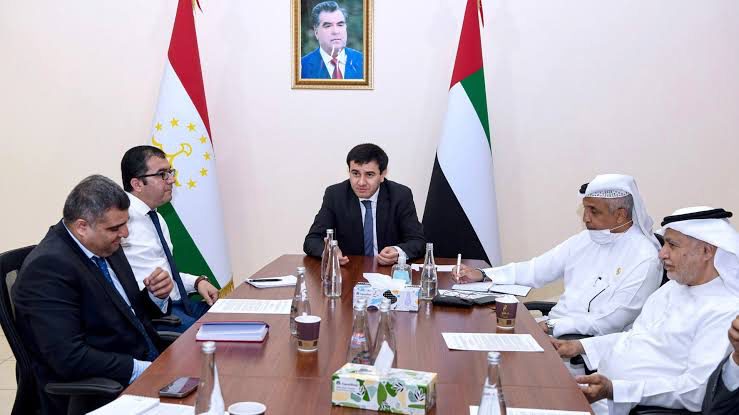
Emerging Markets in UAE-Tajikistan Trade
Emerging markets in both the UAE and Tajikistan offer promising opportunities for investors. In Tajikistan, the government’s focus on infrastructure development, renewable energy, and agribusiness sectors is creating significant growth prospects. For example, the National Development Strategy 2016-2030 aims to attract substantial foreign direct investment to modernize these sectors.
In the UAE, the digital technology, fintech, and sustainable energy markets are attracting significant investments, due to the country’s vision for innovation and economic diversification.
Navigating and Resolving Trade Obstacles
Language and Cultural Barriers
Language and cultural differences pose notable challenges in shipping to Tajikistan. Effective communication is critical for successful trade, yet language barriers can lead to misunderstandings and misinterpretations in contracts, specifications, and negotiations.
Additionally, cultural differences in business practices and etiquette can affect interactions and collaborations. To mitigate these issues, businesses can employ bilingual staff and provide cultural training programs to bridge the communication gap.
Political Instability
Despite Tajikistan’s efforts towards political stability, the country still faces bureaucratic inefficiencies and inconsistent application of laws. These issues create an unpredictable business environment that can deter potential investors and complicate trade operations. Furthermore, regional political tensions and international relations can affect trade policies and agreements.
Addressing these political challenges requires continuous efforts towards improving governance and creating a stable political climate that encourages trade and investment.
Infrastructure Challenges
Inadequate infrastructure can lead to delays, increased transportation costs, and logistical complications.
So, strategic investments in infrastructure development can enhance trade efficiency and reliability. Initiatives such as the Belt and Road Initiative and other multinational cooperation projects aim to improve Tajikistan’s infrastructure. However, progress is gradual and demands sustained investment and support from global partners.
Al Sharqi's Comprehensive Services Enhancing UAE-Tajikistan Trade
Al Sharqi Shipping is a top-quality provider of comprehensive freight forwarding services for Tajikistan. Our services meet the diverse needs of businesses operating in the UAE-Tajikistan trade lane, ensuring efficient, reliable, and cost-effective transportation of goods.
Our experienced handling of diverse cargo types, including standard shipments and specialized consignments, makes us a trusted partner in international trade. At Al Sharqi, we leverage our deep industry knowledge and strategic partnerships to deliver seamless logistics solutions to enhance supply chain efficiency and competitiveness.
Comprehensive Freight Forwarding Services
Our ocean freight solutions include Full Container Load (FCL) and Less than Container Load (LCL) options, providing flexibility and cost efficiency for different shipment sizes.
Partnering with major carriers allows Al Sharqi to offer competitive rates and reliable schedules.
Special Services for Cargo to Tajikistan
Al Sharqi Shipping offers specialized services, including customized solutions for handling sensitive and high-value cargo that comply with regulatory standards.
One notable offering is our Air Cargo Charter Service to Tajikistan, which provides bespoke air freight solutions for large or urgent consignments. This service features dedicated aircraft, flexible scheduling, and unique end-to-end logistics support.
Need dependable freight services to Tajikistan?
Al Sharqi Shipping has you covered. Our expert team ensures your goods arrive safely and on time, every time.
Partner with Al Sharqi today and experience logistics done right. Visit our website for a personalized quote and start your journey towards seamless shipping solutions!
Conclusion
The UAE-Tajikistan trade lane presents significant opportunities for economic cooperation and growth. The future of bilateral trade between the two nations is equally promising, with potential for substantial growth driven by strategic investments and enhanced bilateral agreements.
Majorly, the focus on infrastructure development and streamlined customs processes will be pivotal in driving trade growth. Emerging markets in both nations also offer lucrative opportunities for investors, drive stronger economic ties and mutual growth. By leveraging these opportunities, both countries can achieve significant economic benefits and solidify their positions in regional and global trade networks.
FAQ's
The primary products traded between the UAE and Tajikistan include cars, air conditioners, and unprocessed artificial staple fibers from the UAE, and alkaline metals, planes, helicopters, and gold from Tajikistan.
Tajikistan faces bureaucratic inefficiencies and inconsistent law applications, which can create an unpredictable business environment and deter investors.
Tajikistan’s transport infrastructure, including roads, railways, and airports, needs substantial modernization to handle increasing trade volumes efficiently. Inadequate infrastructure can cause delays and higher transportation costs.
The UAE-Tajikistan trade lane has significant growth potential driven by investments in infrastructure and enhanced bilateral agreements. Both countries are focusing on sectors such as logistics, renewable energy, and technology, which offer numerous opportunities for bilateral investment and trade expansion.
Employing bilingual staff, engaging in cultural training programs, and creating better understanding between partners can help businesses navigate these challenges and collaborate better.
Related Articles
Essential Insights into the UAE-Turkmenistan Trade Lane
Introduction The trade relationship between the UAE and Turkmenistan is increasingly becoming a corn
Navigating the UAE-Tajikistan Trade Route – A Complete Guide
Introduction Over the years, the bilateral trade between the UAE and Tajikistan has shown remarkable





Post a comment
You must be logged in to post a comment.